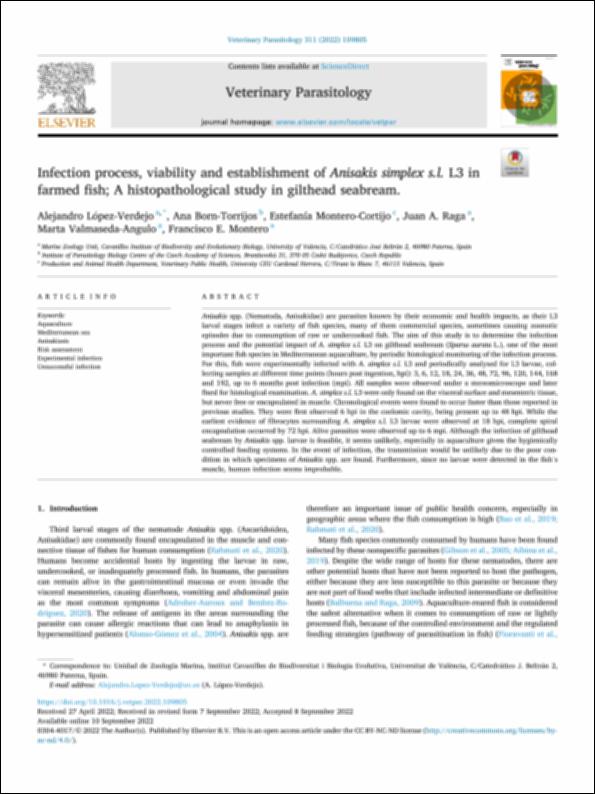Please use this identifier to cite or link to this item:
http://hdl.handle.net/10637/14244Infection process, viability and establishment of "Anisakis simplex s.l." L3 in farmed fish a histopathological study in gilthead seabream
| Title: | Infection process, viability and establishment of "Anisakis simplex s.l." L3 in farmed fish a histopathological study in gilthead seabream |
| Authors : | López Verdejo, Alejandro Born Torrijos, Ana Montero Cortijo, Estefanía Raga, Juan Antonio Valmaseda Angulo, Marta Montero Royo, Francisco Esteban |
| Keywords: | Doradas - Parásitos.; Veterinary histopathology.; Acuicultura.; Histopatología veterinaria.; Doradas - Enfermedades parasitarias.; Sparus auratus - Parasites.; Aquaculture. |
| Publisher: | Elsevier |
| Citation: | López-Verdejo, A., Born-Torrijos, A., Montero-Cortijo, E., Raga, J. A., Valmaseda-Angulo, M. & Montero, F. E. (2022). Infection process, viability and establishment of "Anisakis simplex" s.l. L3 in farmed fish: a histopathological study in gilthead seabream. Veterinary Parasitology, vol. 311, art. 109805 (nov.). DOI: https://doi.org/10.1016/j.vetpar.2022.109805 |
| Abstract: | Anisakis spp. (Nematoda, Anisakidae) are parasites known by their economic and health impacts, as their L3 larval stages infect a variety of fish species, many of them commercial species, sometimes causing zoonotic episodes due to consumption of raw or undercooked fish. The aim of this study is to determine the infection process and the potential impact of A. simplex s.l. L3 on gilthead seabream (Sparus aurata L.), one of the most important fish species in Mediterranean aquaculture, by periodic histological monitoring of the infection process. For this, fish were experimentally infected with A. simplex s.l. L3 and periodically analysed for L3 larvae, collecting samples at different time points (hours post ingestion, hpi): 3, 6, 12, 18, 24, 36, 48, 72, 96, 120, 144, 168 and 192, up to 6 months post infection (mpi). All samples were observed under a stereomicroscope and later fixed for histological examination. A. simplex s.l. L3 were only found on the visceral surface and mesenteric tissue, but never free or encapsulated in muscle. Chronological events were found to occur faster than those reported in previous studies. They were first observed 6 hpi in the coelomic cavity, being present up to 48 hpi. While the earliest evidence of fibrocytes surrounding A. simplex s.l. L3 larvae were observed at 18 hpi, complete spiral encapsulation occurred by 72 hpi. Alive parasites were observed up to 6 mpi. Although the infection of gilthead seabream by Anisakis spp. larvae is feasible, it seems unlikely, especially in aquaculture given the hygienically controlled feeding systems. In the event of infection, the transmission would be unlikely due to the poor condition in which specimens of Anisakis spp. are found. Furthermore, since no larvae were detected in the fish’s muscle, human infection seems improbable. |
| Description: | Este artículo se encuentra disponible en la siguiente URL: https://www.sciencedirect.com/science/article/pii/S0304401722001595 |
| URI: | http://hdl.handle.net/10637/14244 |
| Rights : | http://creativecommons.org/licenses/by-nc-nd/4.0/deed.es |
| ISSN: | 0304-4017 |
| Language: | es |
| Issue Date: | 9-Nov-2022 |
| Center : | Universidad Cardenal Herrera-CEU |
| Appears in Collections: | Dpto. Producción y Sanidad Animal, Salud Pública Veterinaria y Ciencia y Tecnología de los Alimentos |
Items in DSpace are protected by copyright, with all rights reserved, unless otherwise indicated.


